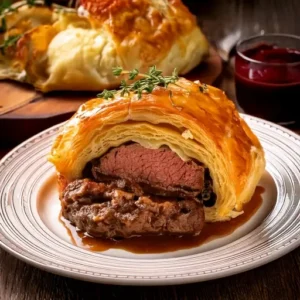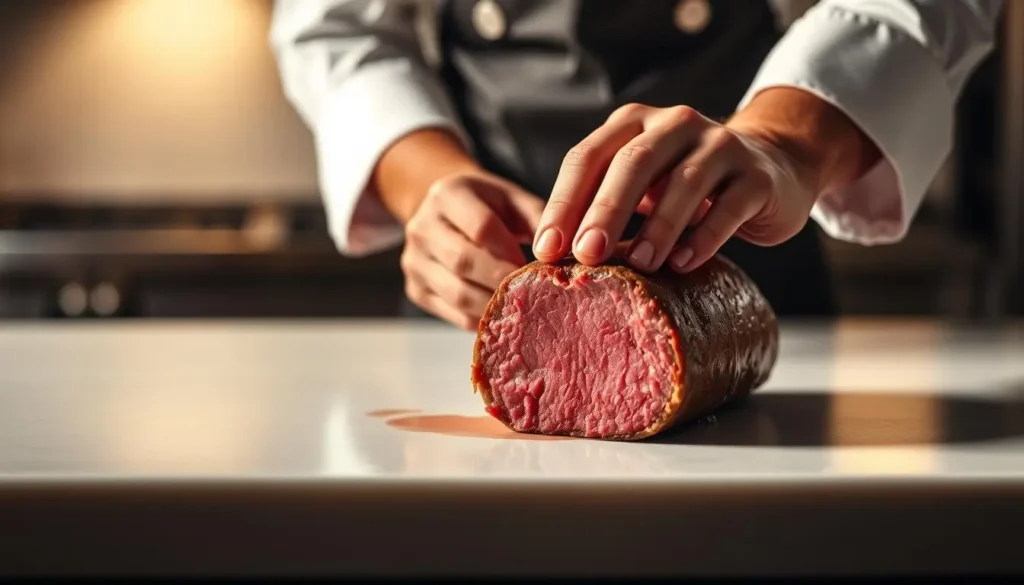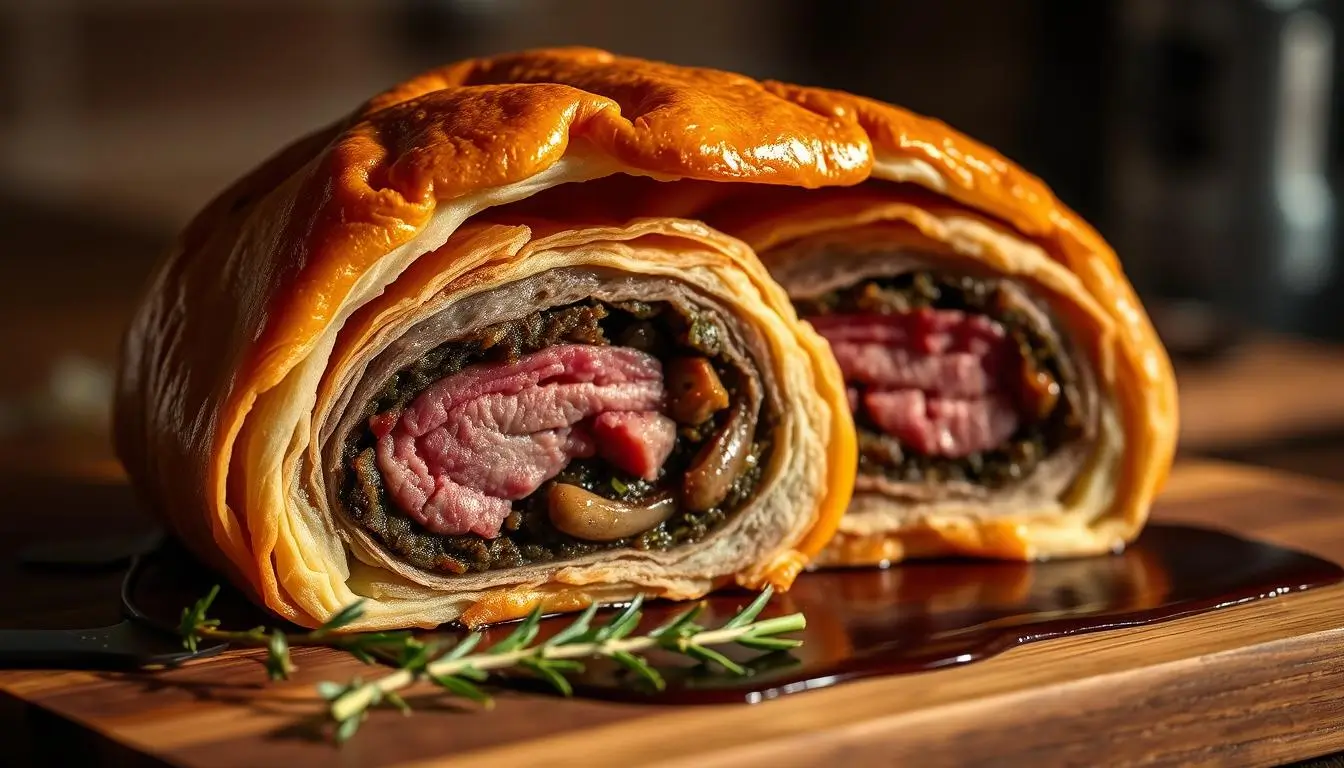Table of Contents
The first time I tried Gordon Ramsay’s Beef Wellington, my kitchen became a place of adventure. It was a test of my cooking passion. This dish is not just a recipe; it’s a journey to the top of elegant home cooking.
As a home cook, I love making dishes that taste like they’re from a restaurant. Gordon Ramsay’s Beef Wellington recipe is more than food; it’s an experience. With a 4.1-star rating, it’s sure to make your cooking better and wow your guests.
Making the perfect Beef Wellington needs precision, patience, and courage. Choosing the best beef tenderloin and wrapping it in pastry is an art. Each step shows the beauty of cooking.
Key Takeaways
- Master a restaurant-quality dish at home
- Learn professional cooking techniques
- Impress guests with a show-stopping meal
- Understand the nuances of high-end cooking
- Develop confidence in complex recipe preparation
Understanding the Classic Beef Wellington Legacy
The story of Beef Wellington is more than just a recipe. It’s a tale of British cuisine and noble traditions.
This dish’s origins are a journey through time. It’s named after Arthur Wellesley, the 1st Duke of Wellington. It’s linked to British military history and culinary innovation.
Origins and Cultural Significance
My research showed the dish’s rich background. Beef Wellington symbolizes sophistication, blending culinary arts with aristocratic heritage. Key historical moments include:
- Created in celebration of the Duke of Wellington’s victory at the Battle of Waterloo in 1815
- First documented in the United States in the Los Angeles Times in 1903
- Became a White House favorite during Richard Nixon’s presidency
Why It’s Called Wellington
The name “Wellington” is full of mystery. It’s linked to the Duke, but the exact connection is debated. Was it his favorite dish? A tribute to his military victories? The mystery makes this beef wellington ingredients-rich dish even more intriguing.
Evolution of the Recipe
Beef Wellington has changed a lot over time. Chefs around the world have made it their own, turning it into a global culinary hit.
| Era | Recipe Characteristics |
|---|---|
| 19th Century | Basic meat preparation with simple pastry |
| Mid-20th Century | Introduction of pâté and mushroom duxelles |
| Modern Day | Gourmet variations with truffle and premium ingredients |
Beef Wellington still fascinates food lovers. It’s a mix of history and modern cooking.
Essential Ingredients for the Perfect Wellington
To make a top-notch beef wellington, you need the right ingredients. These elements come together to create a dish that’s truly memorable. Let’s explore the key parts that elevate this classic dish to new heights.

Gordon Ramsay Beef Wellington: Bold & Delicious
Ingredients
For the Beef Wellington:
- 2 x 400g beef fillets 
- Olive oil for frying 
- 500 g mixture of wild mushrooms cleaned 
- 1 thyme sprig leaves only 
- 500 g puff pastry 
- 8 slices of Parma ham 
- 2 egg yolks beaten with 1 tbsp water and a pinch of salt 
- Sea salt and freshly ground black pepper 
For the Sauce:
- 2 tbsp olive oil 
- 200 g beef trimmings 
- 4 large shallots peeled and sliced 
- 12 black peppercorns 
- 1 bay leaf 
- 1 thyme sprig 
- Splash of vinegar 
- 750 ml beef stock
Instructions
Prepare the Beef:
- Wrap each beef fillet tightly in a triple layer of cling film to set its shape, then chill overnight. 
- Remove the cling film, then quickly sear the beef fillets in a hot pan with a little olive oil for 30-60 seconds until browned all over and rare in the middle. Remove from the pan and leave to cool. 
Prepare the Mushroom Duxelles:
- Finely chop the mushrooms and fry in a hot pan with a little olive oil, thyme leaves, and seasoning. 
- Cook over high heat for about 10 minutes until all excess moisture has evaporated, leaving a mushroom paste (duxelles). Remove from the pan and leave to cool. 
Assemble the Wellington:
- Cut the puff pastry in half, place on a lightly floured surface, and roll each piece into a rectangle large enough to envelop one of the beef fillets. Chill in the refrigerator. 
- Lay a large sheet of cling film on a work surface and place 4 slices of Parma ham in the middle, overlapping them slightly to create a square. 
- Spread half the duxelles evenly over the ham. Season the beef fillets, then place them on top of the mushroom-covered ham. 
- Using the cling film, roll the Parma ham over the beef, then roll and tie the cling film to get a nice, evenly thick log. Repeat with the other beef fillet, then chill for at least 30 minutes. 
Wrap in Pastry:
- Brush the pastry with the egg wash. Remove the cling film from the beef, then wrap the pastry around each ham-wrapped fillet. 
- Trim the pastry and brush all over with the egg wash. Cover with cling film and chill for at least 30 minutes. 
Bake:
- Preheat the oven to 200°C (fan 180°C/gas 6). Place the Wellington on a baking tray and bake until golden and crisp – 20-25 minutes for medium-rare beef, 30 minutes for medium. 
- Allow to stand for 10 minutes before serving in thick slices.
Video
Notes
- Calories: 473 kcal
- Total Fat: 26g
- Saturated Fat: 10g
- Cholesterol: 50mg
- Sodium: 270mg
- Potassium: 600mg
- Total Carbohydrate: 32g
- Dietary Fiber: 2g
- Sugars: 2g
- Protein: 25g
The heart of a great beef wellington with pate is in its ingredients. Here are the must-haves for this dish:
- Beef Tenderloin: A 500g whole beef fillet, chosen for its tenderness and quality
- Puff Pastry: A 150g square piece, rolled to a precise 0.5cm thickness
- Mushroom Duxelles: Made with 250g button mushrooms, 2 garlic cloves, and 1 finely diced shallot
- Prosciutto: 4 thin slices to wrap the beef
- Optional Pâté: Adds an extra layer of rich flavor
The secret to beef wellington with pate is in its layers. Brush the beef fillet with English mustard – about 10g gives it a nice kick. Use triple-layered cling film for a perfect wrap. And 50g of egg yolk makes the pastry golden when brushed.
Pro tip: Take your time when preparing. Chill the beef after searing (30-60 seconds per side) and wrapping. This helps keep the flavors locked in. Bake at 200°C for 15-20 minutes to turn these ingredients into a masterpiece.
Gordon Ramsay Beef Wellington: The Master’s Touch
Making the ultimate gordon ramsay beef wellington needs precision and expert skills. I’ll share the secrets that make this dish the best.
Preparing this dish requires understanding key techniques. Let’s dive into the steps that turn a simple meal into a gourmet experience.
Ramsay’s Signature Searing Technique
The base of a great beef wellington is in the meat prep. Here’s what I suggest:
- Choose a top-notch beef tenderloin
- Sear the meat for 1-2 minutes on each side
- Get a beautiful golden-brown outside
- Shoot for an internal temp of 110°F
The Secret Dijon Mustard Trick
Gordon Ramsay’s genius lies in using subtle yet transformative Dijon mustard. It adds flavor and helps the pastry stick well.
Temperature Control Mastery
Getting the temperature right is crucial. Follow these steps:
- First bake at 400°F for 20 minutes
- Then bake at 350°F for 35-40 minutes
- Use egg wash twice for a perfect golden look
- Freezing before baking can help
Mastering these techniques will make your gordon ramsay beef wellington a hit. The secret is in the details and respecting each ingredient.
Selecting and Preparing the Beef Tenderloin

Choosing the right beef tenderloin is key for a great beef Wellington. I suggest picking a 2 lb tenderloin that’s high-quality. It should be well-marbled and have a uniform shape.
Here are my top tips for selecting and preparing the beef tenderloin:
- Look for a tenderloin weighing approximately 1 kg (2 lb 4 oz)
- Choose meat with consistent marbling for maximum flavor
- Trim any excess fat and silver skin carefully
- Pat the beef completely dry before seasoning
Preparing the tenderloin is an art. I start by seasoning it well with salt and pepper. A quick sear is essential – use 3 tablespoons of olive oil in a hot pan. This creates a golden crust and locks in juices, adding deep flavor to your Beef Wellington.
Temperature control is crucial. For the perfect doneness, aim for these internal temperatures:
- Medium-rare: 125°F (52°C)
- Medium: 135°F (57°C)
Pro tip: After searing, let the beef rest and chill for about 20 minutes. This helps keep its shape and ensures even cooking when you’re ready to finish your traditional beef Wellington recipe.
Mastering the Mushroom Duxelles
Creating the perfect beef wellington starts with the mushroom duxelles. This magical mix adds depth and umami, turning simple ingredients into a masterpiece.
The duxelles is a flavor bomb that needs precision. I’ll show you how to pick the right mushrooms and make a mix that makes your beef wellington stand out.
Selecting Premium Mushrooms
For a top-notch duxelles, mix different mushrooms. My favorites are:
- Baby bella mushrooms for rich, earthy flavor
- Cremini mushrooms for depth
- Shiitake for an intense umami punch
Moisture Control Techniques
Controlling moisture is key for a perfect beef wellington. Here’s how to make an ideal duxelles:
- Finely chop mushrooms with a sharp knife
- Cook mushrooms on medium-high heat
- Stir constantly to evaporate moisture
- Keep cooking until it’s a thick paste
Seasoning Secrets
The right seasonings make your duxelles amazing. My secrets are:
- Fresh thyme
- Minced shallots
- Sea salt
- Freshly ground black pepper
Mastering these steps will give you a mushroom duxelles that’s the heart of a fantastic beef wellington.
The Art of Pastry Wrapping

Mastering pastry wrapping is key for a great beef wellington. I’ll share tips for a perfect pastry cover that will wow everyone.
Before wrapping your beef wellington, make sure you have these tools:
- Plastic wrap
- Sharp kitchen knife
- Puff pastry sheet
- Egg wash
- Baking sheet
For a perfect wellington, you need layers that keep flavor and moisture in. Start by placing plastic wrap on a surface. Then, arrange prosciutto slices in a pattern that overlaps a bit. This keeps the pastry dry.
After that, spread mushroom duxelles over the prosciutto. Use 1.5 tablespoons of duxelles per beef slice. It adds a rich flavor to your dish.
Here’s how to wrap the pastry:
- Roll out the puff pastry to about 1/4 inch thick
- Place the beef in the center
- Fold the pastry edges to seal it tight
- Brush with egg wash for a golden look
Pro tip: Chill the wrapped beef for at least 30 minutes before baking. This keeps the pastry crisp and makes your dish look amazing.
Common Mistakes to Avoid When Making Wellington
Making the perfect beef Wellington can be tough, even for skilled cooks. I’ve found a few big mistakes that can ruin your dish.
Most mistakes happen because of moisture and temperature issues. Here are the main errors to avoid:
- Failing to remove excess moisture from mushroom duxelles
- Skipping the critical searing step for the beef tenderloin
- Improper pastry wrapping techniques
- Incorrect internal meat temperature
Moisture is the biggest problem for a great Wellington. Mushrooms have a lot of water, which can make the pastry soggy. To fix this, cook mushrooms until all water is gone and dry them with paper towels.
| Mistake | Solution |
|---|---|
| Undercooked Pastry | Preheat oven, use egg wash, bake at 425°F |
| Overcooked Beef | Use instant-read thermometer, aim for 135°F |
| Soggy Bottom | Remove moisture, consider par-baking bottom layer |
The Maillard reaction is key for flavor. Sear your beef at high temperatures (at least 310°F) to keep juices in and make a tasty crust. Freezing the wrapped Wellington for 2-3 hours before baking helps it stay firm.
Being patient and precise is essential for this fancy dish. With practice, you’ll get better at this challenging but rewarding recipe!
Conclusion
Now you know how to make Gordon Ramsay’s Beef Wellington at home. It’s all about being precise. Start with a 2-pound beef tenderloin and make the mushroom duxelles with button mushrooms.
Pair your Beef Wellington with a classic sauce for a better dining experience. The sauce should enhance the beef and pastry without overpowering them.
For side dishes, choose something elegant like roasted veggies, creamy mashed potatoes, or a light salad. Baking at 425°F and resting for 10 minutes will help you perfect this dish.
Don’t stop here. Each time you make Beef Wellington, you’ll get better. The fun is in making something amazing from scratch.

